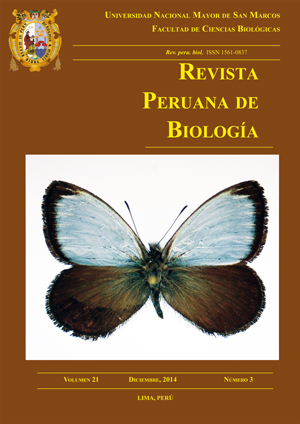Ophioninae (Hymenoptera: Ichneumonidae) wasp community in the cloudy forest Monteseco, Cajamarca, Peru
DOI:
https://doi.org/10.15381/rpb.v21i3.10896Keywords:
Ophioninae, Neotropics, species, diversity, elevation.Abstract
We describe the species composition of the subfamily Ophioninae (Hymenoptera: Ichneumonidae) along an altitudinal gradient in the cloudy forest Monteseco, Cajamarca, Peru collected in 2009 and 2010. Eighteen species were recorded in three genera of Ophioninae: Alophophion, Enicospilus y Ophion. Five species are recorded for the first time in Peru: Ophion polyhymniae Gauld, 1988; Enicospilus cubensis (Norton, 1863); E. guatemalensis (Cameron, 1886); E. cressoni Hooker, 1912 y E. mexicanus (Cresson, 1874). Subfamily composition varies with the elevation. The highest species richness (S=11) was found at 2150 m and the lowest (S=3) at 3116 m. Enicospilus is more diverse from low to mid elevation, Ophion from mid to high elevation and Alophophion occurs predominantly at high elevation.Downloads
Downloads
Published
Issue
Section
License
Copyright (c) 2014 Evelyn Sánchez, Mabel Alvarado, Juan Grados

This work is licensed under a Creative Commons Attribution-NonCommercial-ShareAlike 4.0 International License.
AUTHORS RETAIN THEIR RIGHTS:
a. Authors retain their trade mark rights and patent, and also on any process or procedure described in the article.
b. Authors retain their right to share, copy, distribute, perform and publicly communicate their article (eg, to place their article in an institutional repository or publish it in a book), with an acknowledgment of its initial publication in the Revista Peruana de Biologia.
c. Authors retain theirs right to make a subsequent publication of their work, to use the article or any part thereof (eg a compilation of his papers, lecture notes, thesis, or a book), always indicating its initial publication in the Revista Peruana de Biologia (the originator of the work, journal, volume, number and date).






